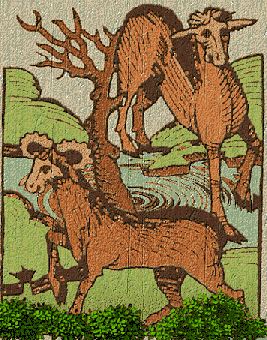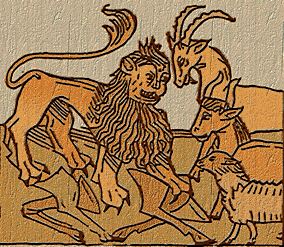Mythological & Symbolic Significance of Goats
August 21, 2012 by pwadmin
Filed under Featured, Raising Goats
General
The goat has long been a visual aid in symbolic and mythological literature and stories. It has a varied significance: gentleness in one tradition and sensuality in another. Both sexes of the goat symbolize fertility, vitality and ceaseless energy. The he-goat (buck) is the epitome of masculine virility and creative energy, while the female (doe) typifies the feminine and generative power and abundance. Symbolically, the goat can be interchanged with the gazelle or the antelope. The wild goat of the Old Testament and Arabic lore is the Ibex.
The goat was probably, after the dog, the earliest domesticated animal. Goats grazing or at rest, or being milked by a goat-herder, are frequent subjects for idyllic scenes, representing the paradisial state; as such they appear on both pagan and Christian sarcophagi.
History
 There have been many strange beliefs and myths about goats. Oppian says they breathe through their horns, while Varro maintains that they breathe through their ears; Pliny expresses a general belief that they are perpetually feverish. Goat skins were used for water and wine bottles when traveling and camping and as parchment for writing. Goat hairs were woven and the animal provided food and milk. The goat, especially the kid, was a sacrificial animal and was used also as a sin-offering (the Scapegoat.) The he-goat is lust personified, and a goat with a human head depicts depravity.
There have been many strange beliefs and myths about goats. Oppian says they breathe through their horns, while Varro maintains that they breathe through their ears; Pliny expresses a general belief that they are perpetually feverish. Goat skins were used for water and wine bottles when traveling and camping and as parchment for writing. Goat hairs were woven and the animal provided food and milk. The goat, especially the kid, was a sacrificial animal and was used also as a sin-offering (the Scapegoat.) The he-goat is lust personified, and a goat with a human head depicts depravity.
Goats in Mythology
The Sumerian god Marduk often has a goat as an accompaniment, and it also appears with hunting goddesses. The wild goat was sacred to Artemis and is an attribute of Dionysos, who took this form when fleeing from Typhon, and of the satyrs, who are half-goats with goats’ horns. Pan also has the legs, horns and beard of a goat. Zeus Dictynnos was suckled by the goat Amalthea, whose skin became the aegis and her horn the cornucopia – she thus represented the protector and preserver, abundance and plenty. The goat was sacrificed to Faunus, who guarded the woods, fields and sheperds of flocks; also to the other nature gods such as Silvanus and Pan.
The goat was used as a draft animal and is depicted at such at Pompeii, with Dionysos/Bacchus reclining in a cart deiven by Cupid and drawn by goats. The she-goat was sacrificed to Artemis at her Athenian festival of Munichia. Herodotus says that the goat skin or aegis was worn by the statues of Athene in the Lybrian sacrifices and rites.
Goats in Religion
 Goats and dogs were sacrificed at the Roman Lupercalia; the “Lupercal” was naked but for a goat skin and he carried goat-skin thongs for the ritual fertility whipping of women in the crowds who put themselves in his way to receive the fertility-magic. The goat, with the horse and dog, could not be touched by the Roman Priest of Jupiter, the Flamen Dialis. The Semitic goat-god Azazel symbolized life and creative energy.
Goats and dogs were sacrificed at the Roman Lupercalia; the “Lupercal” was naked but for a goat skin and he carried goat-skin thongs for the ritual fertility whipping of women in the crowds who put themselves in his way to receive the fertility-magic. The goat, with the horse and dog, could not be touched by the Roman Priest of Jupiter, the Flamen Dialis. The Semitic goat-god Azazel symbolized life and creative energy.
The Hebrew sa’ir, goat, is rendered as satyr in the Old Testament (Isaiah 13: 21 and 34:14) and is an object of worship of false gods (Leviticus 17:7 and II Chronicles 11:15.) The goat also symbolized lewdness. This tradition was carried over into Christianity, where the goat represents the Devil, lust, lubricity and the damned while the sheep sumbolizes the saved. Christ is portrayed as the Scapegoat taking away the sins of the world. But in the Bestiaries, the goat, which climbs the highest peaks and possesses wonderful vision, depicts the highest perfection of searching and the gaze of Christ who sees all, past, present and future.
The Scapegoat
The use of a scapegoat to bear the sins of the entire community is a universal custom, appearing from the rites of ancient Babylon to those of modern-day Japan. The name is derived from the Hebrew ceremonies of the Day of Atonement (Yom Kippur,) when a goat was used to carry away the sins of the people into the wilderness, thus freeing them from the consequences. The scapegoat is delegated guilt and escape from the consequences of sin. The Hebrew Scapegoat was chosen from two goats, one of which was for the Lord. The other, the sin-bearer, was sent into the wilderness for Azazel (Leviticus 16:7-10.) In Christianity, the scapegoat is used as symbolic of Christ suffering for and bearing the sins of the world.
The Ibex
The Nubian Ibex is the wild goat of the Bible and a clean animal for the Hebrews. It is an Arabic symbol of beauty: “more beautiful than a wild goat.” Ibex horns are a frequent motif of Mesopotamian art and in the northern steppes of Asia. Pliny remarks on the great speed of the ibex and says that it hurls itself from heights and lands on its horns, which are elastic and can take the shock, thus it can bounce.
Goats in Folklore
 Arabic lore associates the stately march of the he-goat leading the herd with dignity of manner and bearing; but as contrasted with the meek sheep, it also symbolizes lawlessness, independence and straying. It is a sacrificial animal. The ram and he-goat are attributes of the Vedic Agni, god of fire and creative heat, who rides a he-goat.
Arabic lore associates the stately march of the he-goat leading the herd with dignity of manner and bearing; but as contrasted with the meek sheep, it also symbolizes lawlessness, independence and straying. It is a sacrificial animal. The ram and he-goat are attributes of the Vedic Agni, god of fire and creative heat, who rides a he-goat.
Thor, Scandinavian god of thunder and fertility, has a chariot drawn by goats who are sacred to him; his goat Heidrun supplied the heavenly mead, the drink of the gods. In European literature and folklore, the goat often represented the determined, stubborn side of mankind.
Goats in Oriental Cultures
The Chinese goat spirit Yang Ching is the god of the stay Fan-yin; he is the transcendent goat with white face, horns, a long beard and a special head-dress. He is also a Mongolian god. In Chinese, the goat is a homophone of yang and so represents the solar, masculine principle; it also signifies peace and the good. Russia has a wood-spirit, the Leshi, which resembles Pan and the satyrs in having human shape with the horns, ears and legs of a goat. The goat is frequently used in Heraldry; with horns of a different color, it is said to be “armed.”

Comments